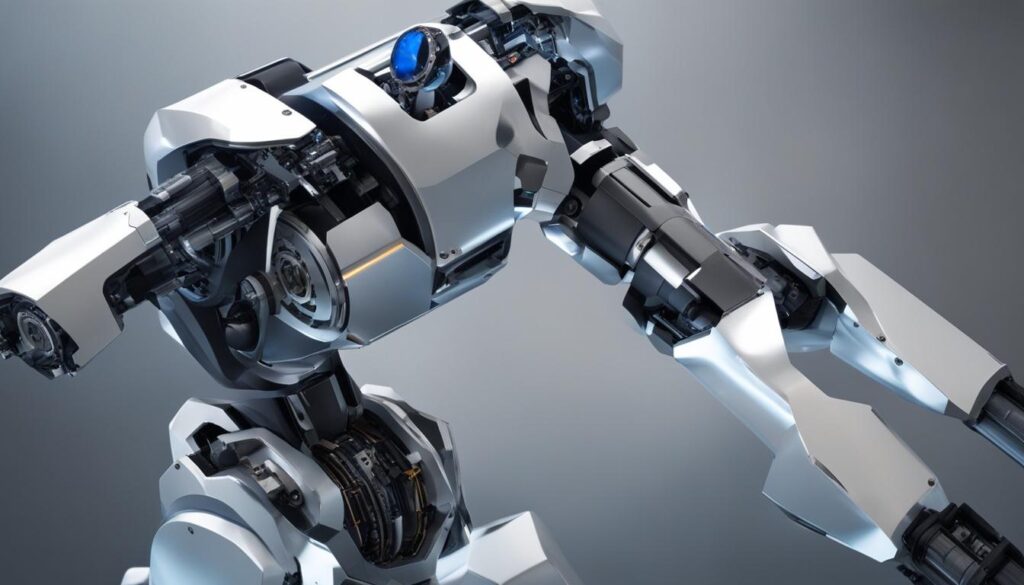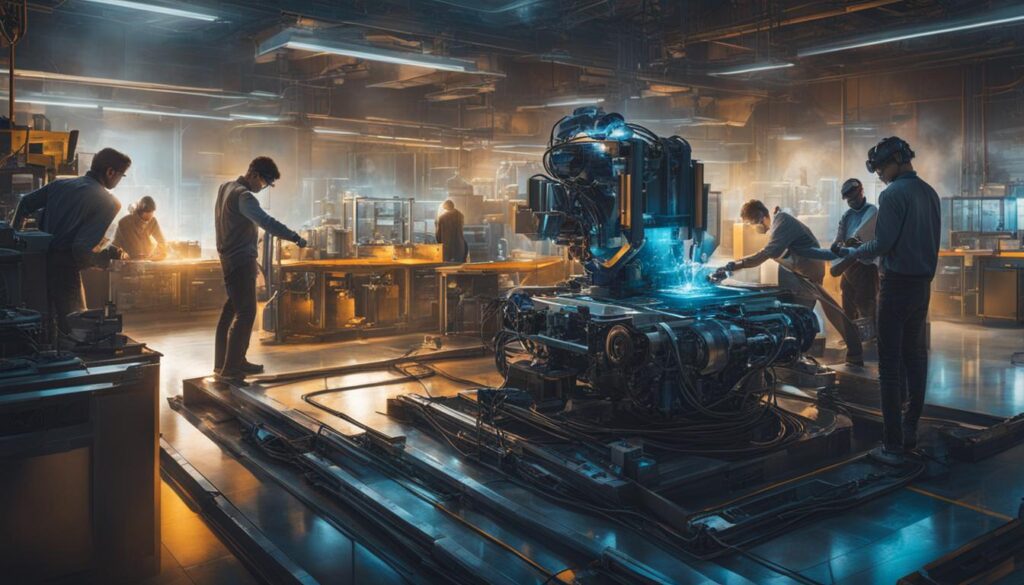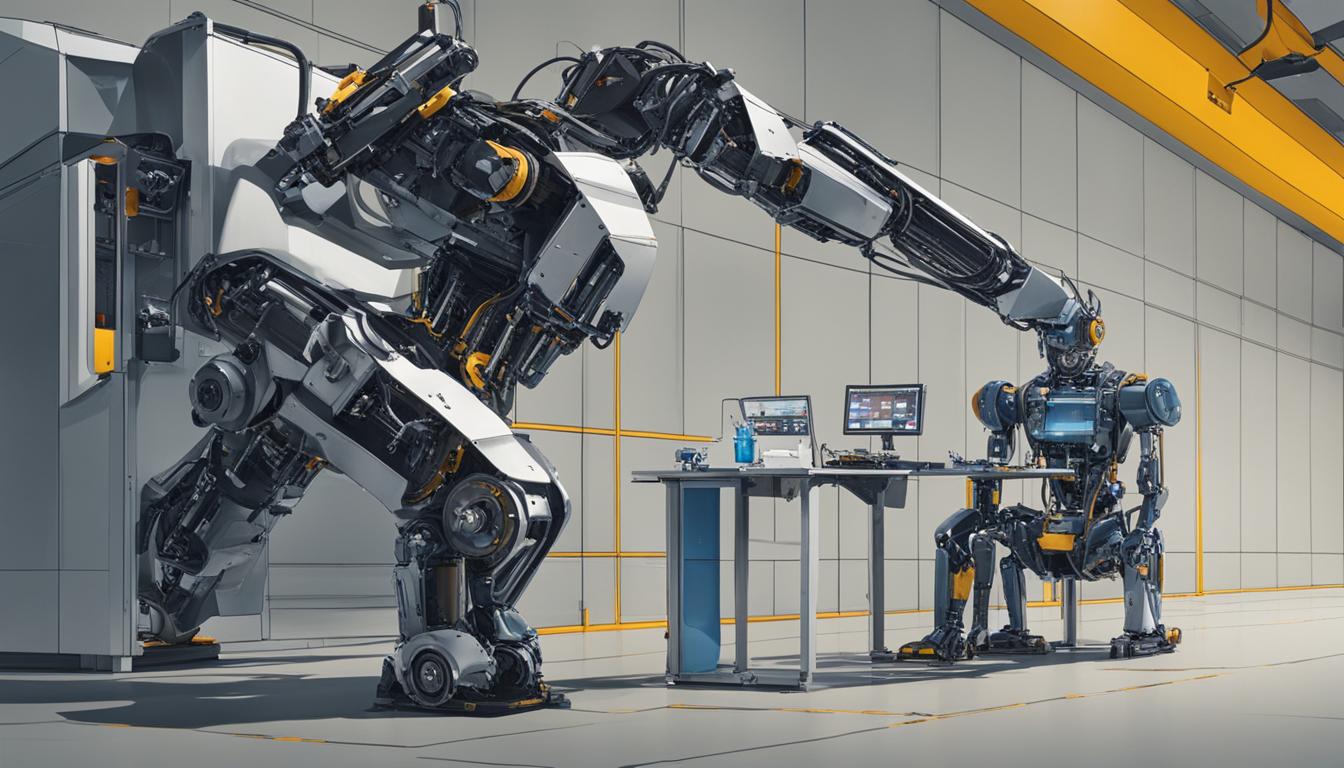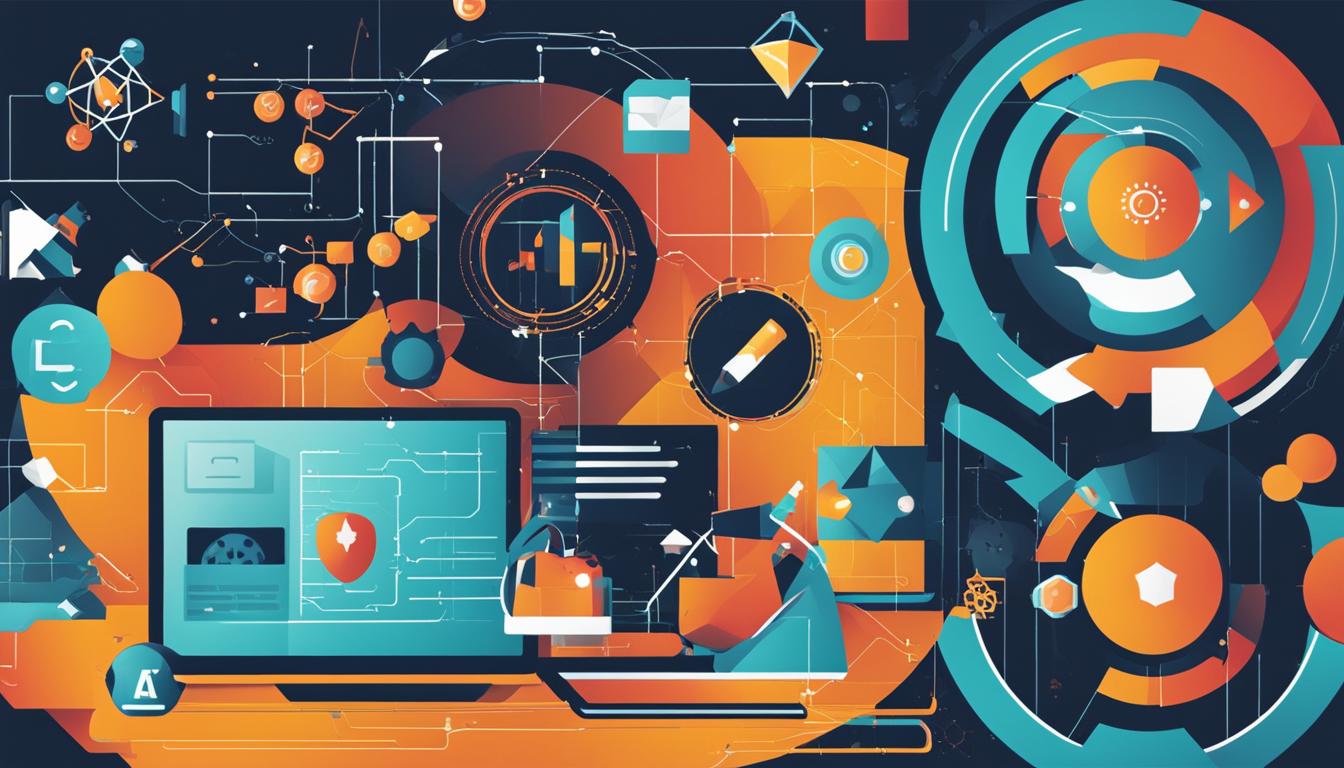In today’s rapidly advancing technological landscape, terms like Artificial Intelligence (AI) and Robotics are often used interchangeably. However, it is important to understand that AI and Robotics are distinct concepts with key differences. Let’s explore the dissimilarities between AI and Robotics to gain a better understanding of their individual roles and capabilities.
Key Takeaways:
- AI focuses on enabling machines to develop intellectual capabilities, while Robotics is the science of designing physical robots for automation.
- Robotics deals with the manipulation of the physical area, while AI is oriented towards the digital part.
- Robotics creates machines that can interact with the environment, while AI focuses on data processing and algorithm design.
- AI is applied in various contexts, from personalized care to education, while Robotics finds applications mainly in industrial sectors for precision tasks.
- The collaboration between AI and Robotics allows for more advanced and autonomous systems, paving the way for future innovations.
What is Artificial Intelligence?
Artificial Intelligence, often referred to as AI, is a branch of computing that focuses on creating machines capable of mimicking human cognitive processes. With AI, algorithms are developed to enable machines to learn autonomously, solve complex problems, understand language, and reason using logic.
One of the key capabilities of AI is its ability to learn and adapt. Through machine learning, AI algorithms can analyze vast amounts of data, identify patterns, and make predictions or decisions based on that information. This enables machines to continuously improve their performance and accuracy over time.
AI has a wide range of applications across various industries. In personalized care, AI can be used to develop intelligent systems that provide tailored recommendations for individual users. In education, AI can enhance learning experiences by adapting the curriculum to the unique needs of students. Additionally, AI plays a crucial role in data analysis, enabling businesses to make informed decisions and gain insights from large datasets.
AI Definition
AI can be defined as the development of algorithms and systems that enable machines to mimic human cognitive processes, learn autonomously, solve problems, understand language, and reason using logic.
AI Capabilities
- Machine learning: AI algorithms can analyze data, identify patterns, and make predictions or decisions based on that information.
- Adaptability: AI systems can continuously learn and improve their performance over time.
- Natural language processing: AI can understand and interpret human language, enabling communication and interaction with users.
- Problem-solving: AI can tackle complex problems by applying logic and reasoning.
What is Robotics?
Robotics is a fascinating discipline that focuses on the design and development of machines capable of automating tasks. It encompasses the creation, programming, and operation of robots to perform specific skills and functions. These robots are equipped with their own mobility and the ability to interact with the environment, making them versatile tools in various industries.
In the realm of robotics, engineers and scientists strive to enhance automation capabilities to increase efficiency and streamline processes. From manufacturing and logistics to healthcare and agriculture, the applications of robotics are vast and diverse.
Table: Applications of Robotics
| Industry | Applications |
|---|---|
| Manufacturing | Assembly line automation, quality control, material handling |
| Logistics | Warehouse management, order fulfillment, autonomous vehicles |
| Healthcare | Surgical assistance, patient care, rehabilitation |
| Agriculture | Harvesting, crop monitoring, precision farming |
Whether it’s the precise movements of robotic arms on an assembly line or the autonomous navigation of drones in agricultural fields, robotics continues to shape and transform various industries, improving productivity and advancing human capabilities.
Differences Between AI and Robotics
When comparing AI and Robotics, it becomes evident that these two fields differ in their approach, scope, and application. AI, or Artificial Intelligence, focuses on the digital domain, involving the development of algorithms and data processing. On the other hand, Robotics is concerned with the physical aspect, encompassing the design and operation of machines that interact with the environment. Let’s explore the key differences between AI and Robotics.
Table: Contrasting AI and Robotics
| AI | Robotics |
|---|---|
| Emphasizes data processing and algorithm design | Focuses on physical manipulation and automation |
| Main goal is to develop machines with cognitive capabilities | Aims to create robots for automation and task execution |
| Applied in various contexts, such as healthcare and education | Primarily used in industries for precision tasks |
AI is often associated with machine learning, natural language processing, and problem-solving. It enables machines to learn, reason, and make decisions based on data. In contrast, Robotics focuses on the physical interaction between machines and the surrounding world. It involves creating robots that can perform precise and repetitive tasks in industrial settings.
While AI and Robotics are distinct fields, they can also collaborate and complement each other. AI technology can enhance the capabilities of robots, enabling them to operate more autonomously and adapt to changing circumstances. This collaboration between AI and Robotics opens up possibilities for advanced systems that combine cognitive abilities with physical manipulation.
In conclusion, the key differences between AI and Robotics lie in their areas of focus and application. AI concentrates on digital data processing and algorithm design, while Robotics deals with physical manipulation and automation. Both fields have their own unique contributions, and their collaboration paves the way for more sophisticated and autonomous systems in the future.
Evolution and Origins
The evolution of AI and the origins of robotics trace back to different periods in history. Robotics, with its focus on physical machines, has a long history dating back to the 17th and 18th centuries. However, the term “robot” was only coined in 1921, giving a name to the field that had been developing for centuries.
On the other hand, AI emerged as a distinct field in 1956, making it a relatively new technology compared to robotics. AI focuses on creating algorithms and enabling machines to mimic human cognitive processes. It has its roots in the study of computational models and the idea of creating machines that can learn, reason, and solve problems autonomously.
Over the years, robotics has evolved with the establishment of dedicated scientific institutes and advancements in technology. AI, on the other hand, often thrives through the efforts of small companies and researchers. While robotics has been primarily used in industrial sectors for automation and precision tasks, AI has found applications in various fields, from personalized care to data analysis.
| Evolution of AI | History of Robotics |
|---|---|
| AI emerged as a distinct field in 1956. | The term “robot” was coined in 1921. |
| AI focuses on algorithms and cognitive processes. | Robotics focuses on physical machines and automation. |
| Sometimes developed by small companies and researchers. | Has dedicated scientific institutes and research. |
| Applications range from personalized care to data analysis. | Primarily used in industrial sectors for automation. |
While the fields of AI and robotics have distinct origins and areas of focus, their collaboration opens up new possibilities for advanced technologies. As AI continues to improve the learning and application capabilities of robots, we can expect to see more autonomous systems with advanced functionalities. The future of AI and robotics holds the potential for groundbreaking innovations that will shape various industries and the way we interact with machines.

Key Points:
- Robotics has a long history dating back to the 17th and 18th centuries, while AI emerged in 1956.
- AI focuses on algorithms and cognitive processes, while robotics focuses on physical machines and automation.
- Robotics has dedicated scientific institutes and research, while AI is often developed by small companies and researchers.
- Applications of AI range from personalized care to data analysis, while robotics is primarily used in industrial sectors.
- The collaboration between AI and robotics opens up possibilities for advanced and autonomous systems.
AI and Robotics Collaboration
AI and Robotics are two fields that have found immense value in collaboration and working together. The combination of AI’s cognitive capabilities and Robotics’ physical manipulation abilities has led to the development of advanced systems that can perform complex tasks with minimal human intervention. This collaboration between AI and Robotics is paving the way for the era of human-machine collaboration, where humans and machines work together to enhance productivity and efficiency.
One significant outcome of this collaboration is the emergence of collaborative robots, also known as cobots. Cobots are designed to work alongside humans, assisting them in various tasks. They are equipped with sensors and AI algorithms that enable them to safely interact with humans and adapt to dynamic environments. Cobots find applications in industries such as manufacturing, healthcare, and logistics, where they perform repetitive or physically demanding tasks, allowing human workers to focus on more complex and creative responsibilities.
The collaboration between AI and Robotics also extends to the development of intelligent robotic systems that leverage AI algorithms to enhance their decision-making capabilities. These systems can analyze vast amounts of data in real-time, enabling them to make autonomous decisions and adapt to changing conditions. In manufacturing, for example, AI-powered robots can optimize production processes, identify defects, and predict maintenance needs, resulting in increased efficiency and reduced downtime.
The table below highlights some of the key aspects of AI and Robotics collaboration:
| Aspect | AI | Robotics |
|---|---|---|
| Collaboration | AI enhances the learning and decision-making capabilities of robots | Robotics provides the physical platform for AI algorithms to be applied |
| Task Performance | AI enables robots to perform complex tasks autonomously | Robotics enables physical manipulation and interaction with the environment |
| Human-Machine Interaction | AI algorithms enable robots to understand and respond to human commands and gestures | Robotics provides the physical platform for human-robot collaboration |
| Application | AI and Robotics collaboration finds applications in industries such as manufacturing, healthcare, and logistics | Robotics is used in various sectors where physical manipulation and automation are required |
As AI and Robotics continue to evolve and advance, their collaboration holds great promise for the future. The integration of AI algorithms into robotic systems will lead to the development of more intelligent and adaptable machines. This, in turn, will enable humans to focus on higher-level tasks, while machines handle repetitive and physically demanding work. The possibilities of AI and Robotics collaboration are vast and will undoubtedly transform various industries and improve our daily lives.

AI in Robotics Applications
Artificial Intelligence (AI) is revolutionizing the field of robotics, enabling machines to perform complex tasks with autonomy and intelligence. AI has found applications in various areas of robotics, including manufacturing, healthcare, and household assistance.
In manufacturing, AI-driven robots are used for turnkey robotics and automation tasks. These robots are equipped with advanced algorithms and sensors that enable them to perform intricate operations with precision and efficiency. They can handle complex assembly processes, quality control, and even adapt to changing production demands.
In healthcare, AI robots are assisting medical professionals in various ways. They can be used for tasks such as patient monitoring, medication management, and even surgical procedures. AI-powered robots can analyze medical data, make intelligent recommendations, and enhance the overall efficiency of healthcare delivery.
AI is also making its way into households through autonomous home assistants. These robots can perform tasks like cleaning, organizing, and even providing companionship. With advancements in natural language processing and machine learning, AI robots are becoming more intuitive and capable of understanding and responding to human needs.
Table: AI Applications in Robotics
| Industry | Applications |
|---|---|
| Manufacturing | Turnkey robotics, automation tasks, complex assembly processes |
| Healthcare | Patient monitoring, medication management, surgical procedures |
| Household | Cleaning, organizing, companionship |
As AI continues to advance, the capabilities of robots are expected to expand even further. AI algorithms are constantly improving, allowing robots to learn from their environment and make autonomous decisions. This opens up new possibilities for robotics applications in various industries, from transportation and logistics to agriculture and beyond.
With the combination of AI and robotics, we can expect to see more intelligent and adaptable machines that can work alongside humans, enhancing productivity and efficiency in diverse fields. The future of AI in robotics is promising and holds great potential for transforming industries and improving our daily lives.
Conclusion
In conclusion, the fields of AI and Robotics offer distinct yet complementary technologies. AI focuses on cognitive processes and learning, while Robotics specializes in the design and physical manipulation of machines. The collaboration between AI and Robotics has paved the way for more advanced and autonomous systems.
Looking ahead, the future of AI and Robotics holds great promise. As technology continues to advance, we can expect the line between these fields to become increasingly blurred, leading to new innovations and advancements. AI robots will play a crucial role in various industries and sectors, from manufacturing to healthcare.
With the integration of AI and Robotics, we can envision intelligent machines that possess advanced functionalities and autonomous decision-making capabilities. As we navigate the exciting possibilities that the future holds, it is clear that AI and Robotics will continue to shape and transform our world in remarkable ways.
FAQ
What is the difference between AI and Robotics?
AI focuses on enabling machines to develop intellectual capabilities, while Robotics is the science of designing physical robots for automation. AI is oriented towards the digital part, while Robotics deals with the manipulation of the physical area.
What is Artificial Intelligence?
Artificial Intelligence is a branch of computing that studies how machines can mimic human cognitive processes. It involves creating algorithms for machines to learn autonomously, solve problems, understand language, and reason using logic.
What is Robotics?
Robotics is the discipline that deals with designing machines capable of automating tasks. It involves creating, programming, and operating automated elements to perform specific skills and tasks. Robots have their own mobility and can interact with the environment.
What are the differences between AI and Robotics?
AI focuses on the internal or digital part, while Robotics focuses on the physical manipulation. Robotics creates machines that can interact with the environment, while AI focuses on data processing and algorithm design. In terms of application, Robotics is used in industries for tasks that require physical manipulation, while AI is applied in various contexts, from personalized care to data analysis.
What is the evolution and origin of AI and Robotics?
Robotics has a long history dating back to the 17th and 18th centuries, while AI emerged in 1956. Robotics has evolved with the establishment of scientific institutes dedicated to robot design. AI, on the other hand, is often developed by small companies and raises concerns about privacy and the displacement of human labor.
How do AI and Robotics collaborate?
AI improves the learning and application capabilities of robots, enabling them to perform tasks more autonomously. Human-machine collaboration is becoming more common, with machines collaborating with humans to improve different tasks. Cobots, or collaborative robots, are designed to perform tedious tasks in collaboration with humans.
How is AI used in Robotics applications?
AI is used in various robotic applications. For example, AI is used in manufacturing for turnkey robotics and complex automation tasks. In healthcare, AI-driven robots can assist medical professionals and perform lower-skilled work. AI also plays a role in household robots, such as autonomous home assistants.
 Skip to main content
Skip to main content


